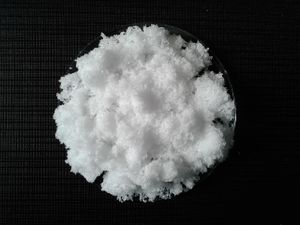Difference between revisions of "Oxalic acid"
(Created page with "Oxalic acid dihydrate. 152x152px '''Oxalic acid''' is an organic compound with the chemical formu...") |
|||
| Line 44: | Line 44: | ||
*[http://www.sciencemadness.org/talk/viewthread.php?tid=12832#pid162568 oxidation of diols] | *[http://www.sciencemadness.org/talk/viewthread.php?tid=12832#pid162568 oxidation of diols] | ||
*[http://www.sciencemadness.org/talk/viewthread.php?tid=11153 Drying Oxalic Acid Dihydrate to Anhydrous] | *[http://www.sciencemadness.org/talk/viewthread.php?tid=11153 Drying Oxalic Acid Dihydrate to Anhydrous] | ||
| + | |||
| + | [[Category:Acids]] | ||
| + | [[Category:Carboxylic acids]] | ||
Revision as of 17:58, 2 August 2015
Oxalic acid is an organic compound with the chemical formula H2C2O4. Along with formic acid, it is one of the most corrosive organic acids.
Contents
Properties
Chemical
Oxalic acid is very strong for an organic acid. It will react with manganese dioxide to form manganese oxalate and carbon dioxide.
- MnO2 + 2 H2C2O4 → MnC2O4 + 2 CO2 + 2H2O
Physical
Oxalic acid is a colorless hygroscopic crystalline solid, with a snow-like aspect. It is soluble in water (143 g/L at 25˚C), more soluble in ethanol (240 g/L) but poorly soluble in ether (18 g/L). It has a weak smell and is irritating to skin. It has a melting point of 102 °C and sublimes between 149 - 160 °C.
Availability
Oxalic acid is sometimes available as wood bleach or as beehive disinfecting powder. It can also be bought online, such as from Amazon. "Bar Keepers Friend" is a very cheap multi-surface cleaner containing oxalic acid dihydrate, available at hardware stores.
Preparation
Oxalic acid can be made from the oxidation of sucrose, glucose, or ethylene glycol using nitric acid or air in the presence of vanadium pentoxide.
Below is a synthesis of oxalic acid found online, using nitric acid and sucrose:
10 g of sugar are added in a flat bottom flask and 50 ml of concentrated nitric acid and heat the flask in a water bath. The reaction will yield nitrogen oxide fumes, so it's best performed outside or in a fume hood. Stop the heating and remove the flask from the water bath. When the reaction subsides, add the hot solution into an evaporating basin. Wash out the flask with 10 ml of conc. nitric acid and evaporate the solution on the water bath until it has a volume of 10 ml. Add 20 ml of water to the solution and evaporate again to 10 ml. Cool the solution in a cooling bath to crystallize the oxalic acid. Dry the crystals.[1]
Projects
- Purifying MnO2 from old batteries
- Making formic acid by distillation of oxalic acid with glycerol
- Lanthanide purification
- Make pyrophoric iron
- Oxalate esters
Handling
Safety
Oxalic acid is corrosive to human tissues, so proper protection must be worn. It is not extremely volatile, so its vapors aren't usually a hazard. Oxalates are the notorious cause of kidney stones, so ingestion of both acid and salt should be avoided.
Storage
Should be stored in closed bottles.
Disposal
Oxalic acid and oxalates can be destroyed with hydrogen peroxide.[2]
References
- ↑ http://www.scribd.com/doc/45869039/preparation-of-Oxalic-acid
- ↑ http://web.ornl.gov/info/reports/1981/3445605762877.pdf
